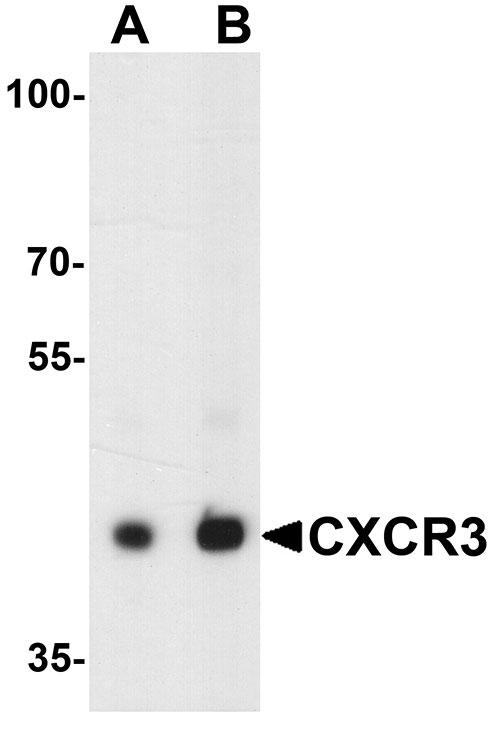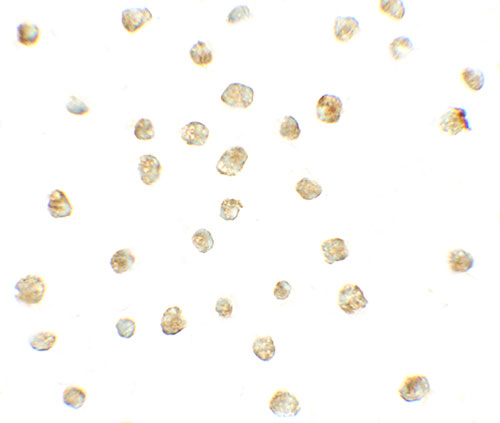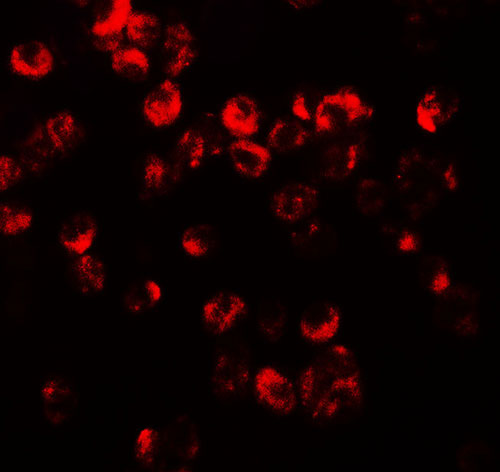CXCR3 Antibody
- SPECIFICATION
- CITATIONS
- PROTOCOLS
- BACKGROUND

Application
| WB, IF, ICC, E |
|---|---|
| Primary Accession | P49682 |
| Other Accession | NP_001136269, 218563730 |
| Reactivity | Human, Mouse, Rat |
| Host | Rabbit |
| Clonality | Polyclonal |
| Isotype | IgG |
| Calculated MW | Predicted: 46 kDa Observed: 43 kDa |
| Application Notes | CXCR3 antibody can be used for detection of CXCR3 by Western blot at 1 - 2 µg/ml. Antibody can also be used for Immunocytochemistry at 5 µg/mL. For Immunoflorescence start at 20 µg/mL. |
| Gene ID | 2833 |
|---|---|
| Target/Specificity | CXCR3; CXCR3 antibody is human, mouse and rat reactive. At least two isoforms of CXCR3 are known to exist; this antibody will detect both isoforms. |
| Reconstitution & Storage | CXCR3 antibody can be stored at 4℃ for three months and -20℃, stable for up to one year. |
| Precautions | CXCR3 Antibody is for research use only and not for use in diagnostic or therapeutic procedures. |
| Name | CXCR3 |
|---|---|
| Synonyms | GPR9 |
| Function | [Isoform 1]: Receptor for the C-X-C chemokine CXCL9, CXCL10 and CXCL11 and mediates the proliferation, survival and angiogenic activity of human mesangial cells (HMC) through a heterotrimeric G- protein signaling pathway (PubMed:12782716). Binds to CCL21. Probably promotes cell chemotaxis response. Upon activation by PF4, induces activated T-lymphocytes migration mediated via downstream Ras/extracellular signal-regulated kinase (ERK) signaling. [Isoform 3]: Mediates the activity of CXCL11. |
| Cellular Location | [Isoform 1]: Cell membrane; Multi-pass membrane protein |
| Tissue Location | Isoform 1 and isoform 2 are mainly expressed in heart, kidney, liver and skeletal muscle. Isoform 1 is also expressed in placenta. Isoform 2 is expressed in endothelial cells. Expressed in T-cells (at protein level). |

Thousands of laboratories across the world have published research that depended on the performance of antibodies from Abcepta to advance their research. Check out links to articles that cite our products in major peer-reviewed journals, organized by research category.
info@abcepta.com, and receive a free "I Love Antibodies" mug.
Provided below are standard protocols that you may find useful for product applications.
Background
The CXCR3 protein is a G protein-coupled receptor with selectivity for three chemokines, termed CXCL9/Mig (monokine induced by interferon-gamma), CXCL10/IP10 (interferon-gamma-inducible 10 kDa protein) and CXCL11/I-TAC (interferon-inducible T cell alpha-chemoattractant) (reviewed in 1). Binding of chemokines to this protein induces cellular responses that are involved in leukocyte traffic, most notably integrin activation, cytoskeletal changes and chemotactic migration (2). Similar to other chemokine receptors such as CXCR4, CXCR3 has been implicated in several malignancies as a biomarker of tumor behavior as well as a potential therapeutic target (3).
References
Groom JR and Luster AD. CXCR3 ligands: redundant, collaborative and antagonistic functions. Immunol. Cell Biol. 2011; 89:207-15.
Maghazachi AA. Role of chemokines in the biology of natural killer cells. Curr. Top Microbiol. Immunol. 2010; 341:37-58.
Fulton AM. The chemokine receptors CXCR4 and CXCR3 in cancer. Curr. Oncol. Rep. 2009; 11:125-31.
If you have used an Abcepta product and would like to share how it has performed, please click on the "Submit Review" button and provide the requested information. Our staff will examine and post your review and contact you if needed.
If you have any additional inquiries please email technical services at tech@abcepta.com.













 Foundational characteristics of cancer include proliferation, angiogenesis, migration, evasion of apoptosis, and cellular immortality. Find key markers for these cellular processes and antibodies to detect them.
Foundational characteristics of cancer include proliferation, angiogenesis, migration, evasion of apoptosis, and cellular immortality. Find key markers for these cellular processes and antibodies to detect them. The SUMOplot™ Analysis Program predicts and scores sumoylation sites in your protein. SUMOylation is a post-translational modification involved in various cellular processes, such as nuclear-cytosolic transport, transcriptional regulation, apoptosis, protein stability, response to stress, and progression through the cell cycle.
The SUMOplot™ Analysis Program predicts and scores sumoylation sites in your protein. SUMOylation is a post-translational modification involved in various cellular processes, such as nuclear-cytosolic transport, transcriptional regulation, apoptosis, protein stability, response to stress, and progression through the cell cycle. The Autophagy Receptor Motif Plotter predicts and scores autophagy receptor binding sites in your protein. Identifying proteins connected to this pathway is critical to understanding the role of autophagy in physiological as well as pathological processes such as development, differentiation, neurodegenerative diseases, stress, infection, and cancer.
The Autophagy Receptor Motif Plotter predicts and scores autophagy receptor binding sites in your protein. Identifying proteins connected to this pathway is critical to understanding the role of autophagy in physiological as well as pathological processes such as development, differentiation, neurodegenerative diseases, stress, infection, and cancer.




